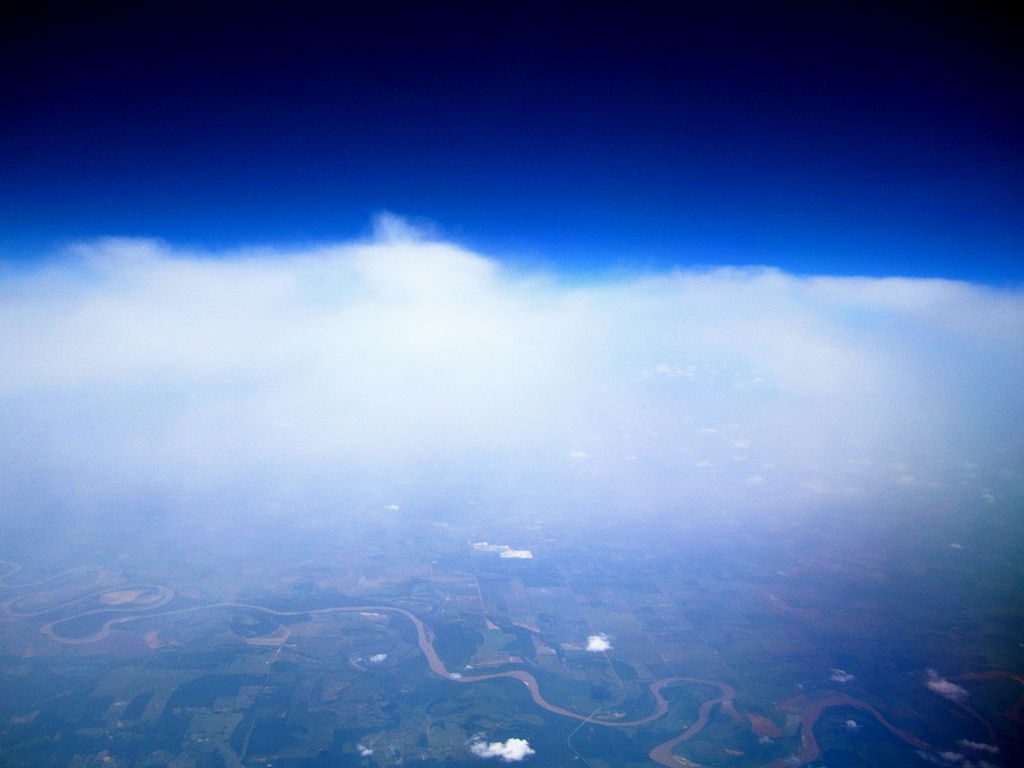STUDY: Atmospheric Processes Vocabulary
Atmospheric Processes Vocabulary

Photo courtesy of Wikimedia.
Earth's Atmosphere
Acid rain: when the pH of precipitation is lowered below a pH of 5, meaning it is more acidic than normal
Air pollution: any substance released into the atmosphere in harmful/unnatural amounts
Air pressure: force of air weighing down over a unit of area
Convection: heat transferred through the movement of a fluid (e.g. air or water)
Heat: energy transferred from one object to another
Latent heat: heat taken in or released when an object changes state (solid, liquid, gas)
Ozone: 3 oxygen atoms
Particulate matter: droplets and solid materials suspended in the air
Specific heat: amount of energy required to raise the temperature of one gram of the material by one degree C
Temperature: measure of how fast the atoms in a material are vibrating
Temperature gradient: change in temperature with distance
Solar Energy Distribution
Albedo: percentage of solar radiation reflected back into space
Conduction: transfer of heat through direct contact between objects
Convection: transfer of heat through the movement of a fluid or gas
Convection Current: circulating path of heat transfer by material heating and rising and cooling and sinking
Heat: energy transported between objects of two different temperatures
Infrared: sun's radiation that has lower wavelenth than visible light
Mitochondria: cell structures that convert energy that has been stored as carbohydrates into ATP
Photosynthesis: process by which plants create energy from the sun and carbon dioxide and water
Radiation: transfer of energy by electromagnetic waves
Ultraviolet: sun's energy that has highest wavelength
Greenhouse Effect
Antarctic Circle: located at 66.5 ºS latitude
Arctic Circle: located at 66.5 ºN latitude
Coriolis Effect: occurs due to Earth's rotation; causes objects to move in a curved path rather than a straight line
Intertropical Convergence Zone: located where the northern and southern trade winds meet at the equator; characterized by stormy weather
North Pole: located at 90 ºN latitude
Polar Easterlies: global wind system located near the poles, starting at 60º N and S latitudes and extending poleward
Prevailing Westerlies: global wind systems located in the norhtern and southern hemispheres in a zone between 30-60º N and S latitude
Revolution: amount of time it takes Earth to complete one trip around the sun; 365 days
Rotation: amount of time it takes Earth to complete one spin on its axis; 24 hours
South Pole: located at 90 ºS latitude
Subpolar Low: zone of low pressure located between the polar easterlies and prevailing westerlies
Subtropical High: high pressure zone associated with the trade winds
Trade Winds: global wind system located between 30ºN and 30ºS latitude
Weather & Climate
Albedo: fraction of solar radiation that is reflected back to space
Anemometer: instrument used to measure wind speed
Barometer: instrument used to measure air pressure
Climate: average weather of an area over a period of 30+ years
Climatologist: scientist that studies climate
Dew Point: temperature to which air must be cooled to be saturated
Front: boundary between 2 air masses
Humidity: the amount of water vapor held in the air
Hurricanes: tropical, cyclonic storms that produce winds that travel at 120-240 mph
Hygrometer: instrument used to measure humidity
Precipitation: water falling from clouds
Relative Humidity: percentage of moisture in the air
Revolution: amount of time it takes Earth to complete one trip around the sun; 365 days
Rotation: amount of time it takes Earth to complete one spin on its axis; 24 hours
Saturated: when air contains as much moisture as it can possibly hold; relative humidity is 100%
Supercells: most powerful thunderstorms; required for tornado formation
Tropic of Cancer: located at 23.5 ºN latitude
Tropic of Capricorn: located at 23.5 ºS latitude
Vortices: spinning columns of air
Weather: describes present state of the atmosphere and current conditions.
After you have completed this part of the lesson, you can check the box for this lesson piece in the course to mark it as complete